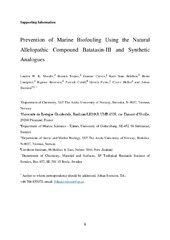| dc.contributor.author | Moodie, Lindon | |
| dc.contributor.author | Trepos, Rozenn | |
| dc.contributor.author | Cervin, Gunnar | |
| dc.contributor.author | Bråthen, Kari Anne | |
| dc.contributor.author | Lindgård, Bente | |
| dc.contributor.author | Reiersen, Rigmor | |
| dc.contributor.author | Cahill, Patrick | |
| dc.contributor.author | Pavia, Henrik | |
| dc.contributor.author | Hellio, Claire | |
| dc.contributor.author | Svenson, Johan | |
| dc.date.accessioned | 2018-08-13T08:56:49Z | |
| dc.date.available | 2018-08-13T08:56:49Z | |
| dc.date.issued | 2017-06-21 | |
| dc.description.abstract | The current study reports the first comprehensive evaluation of a class of allelopathic terrestrial natural products as antifoulants in a marine setting. To investigate the antifouling potential of the natural dihydrostilbene scaffold, a library of 22 synthetic dihydrostilbenes with varying substitution patterns, many of which occur naturally in terrestrial plants, were prepared and assessed for their antifouling capacity. The compounds were evaluated in an extensive screen against 16 fouling marine organisms. The dihydrostilbene scaffold was shown to possess powerful general antifouling effects against both marine microfoulers and macrofoulers with inhibitory activities at low concentrations. The species of microalgae examined displayed a particular sensitivity toward the evaluated compounds at low ng/mL concentrations. It was shown that several of the natural and synthetic compounds exerted their repelling activities via nontoxic and reversible mechanisms. The activities of the most active compounds such as 3,5-dimethoxybibenzyl (5), 3,4-dimethoxybibenzyl (9), and 3-hydroxy-3′,4,5′-trimethoxybibenzyl (20) were comparable to the commercial antifouling booster biocide Sea-nine, which was employed as a positive control. The investigation of terrestrial allelopathic natural products to counter marine fouling represents a novel strategy for the design of “green” antifouling technologies, and these compounds offer a potential alternative to traditional biocidal antifoulants. | en_US |
| dc.description.sponsorship | VINNOVA
Centre for Marine Chemical Ecology at the University of Gothenburg
Biogenouest at the University of Western Brittany
New Zealand Ministry of Business, Innovation and Employment (MBIE)
Norges forskningsråd (508288) | en_US |
| dc.description | This document is the Accepted Manuscript version of a Published Work that appeared in final form in Journal of Natural Products, copyright © American Chemical Society after peer review and technical editing by the publisher. To access the final edited and published work see <a href=https://doi.org/10.1021/acs.jnatprod.7b00129> https://doi.org/10.1021/acs.jnatprod.7b00129</a>. | en_US |
| dc.identifier.citation | Moodie, L.W.K., Treops, R., Cervin, G., Bråthe, K.A., Lindgård, B., Reiersen, R., ... Svenson, J. (2017). Prevention of Marine Biofouling Using the Natural Allelopathic Compound Batatasin-III and Synthetic Analogues. Journal of Natural Products, 80(7), 2001-2011. https://doi.org/10.1021/acs.jnatprod.7b00129 | en_US |
| dc.identifier.cristinID | FRIDAID 1544195 | |
| dc.identifier.doi | 10.1021/acs.jnatprod.7b00129 | |
| dc.identifier.issn | 0163-3864 | |
| dc.identifier.issn | 1520-6025 | |
| dc.identifier.uri | https://hdl.handle.net/10037/13379 | |
| dc.language.iso | eng | en_US |
| dc.publisher | American Chemical Society | en_US |
| dc.relation.journal | Journal of natural products | |
| dc.rights.accessRights | openAccess | en_US |
| dc.subject | VDP::Matematikk og Naturvitenskap: 400::Zoologiske og botaniske fag: 480 | en_US |
| dc.subject | VDP::Mathematics and natural science: 400::Zoology and botany: 480 | en_US |
| dc.title | Prevention of Marine Biofouling Using the Natural Allelopathic Compound Batatasin-III and Synthetic Analogues | en_US |
| dc.type | Journal article | en_US |
| dc.type | Tidsskriftartikkel | en_US |
| dc.type | Peer reviewed | en_US |


 English
English norsk
norsk
